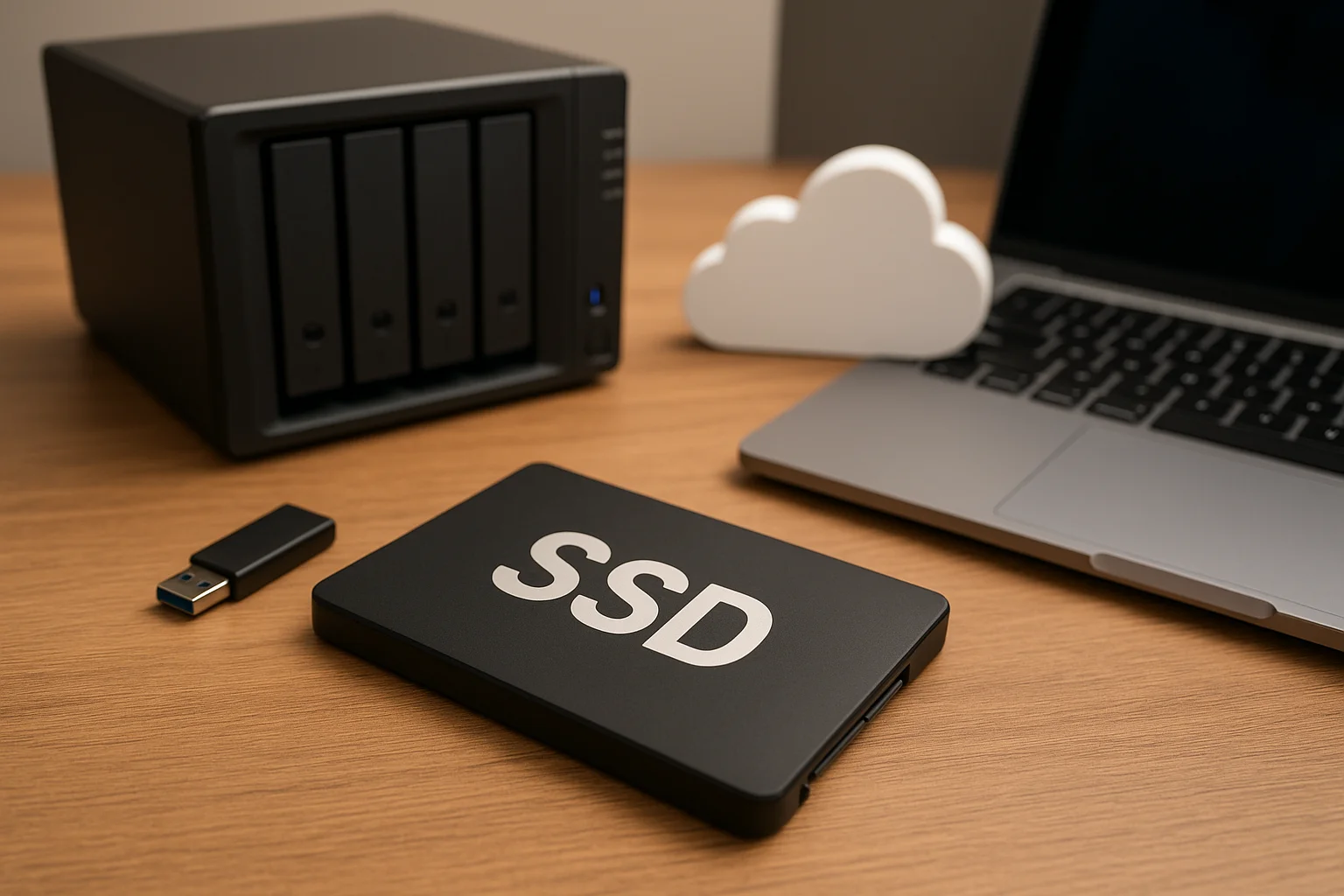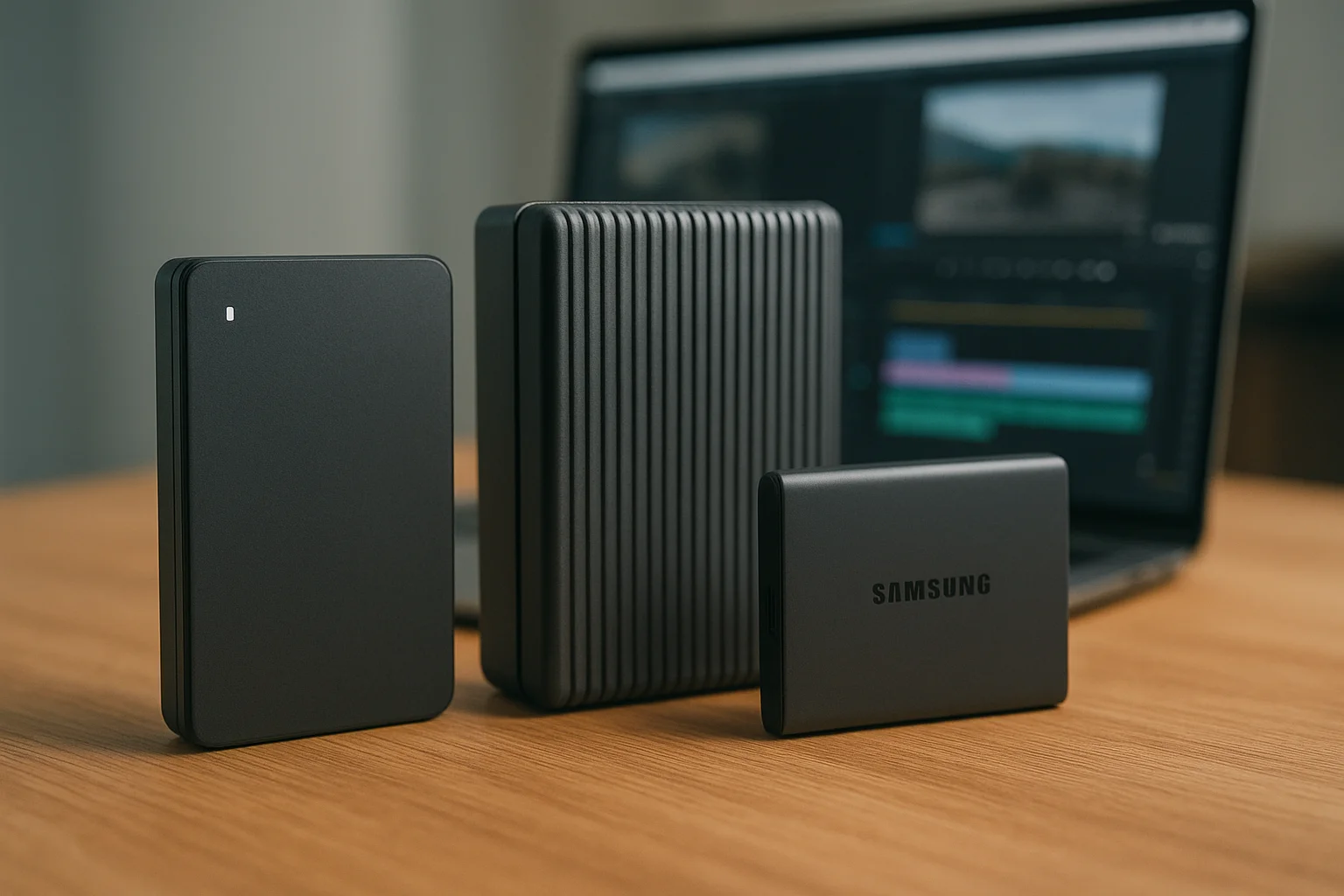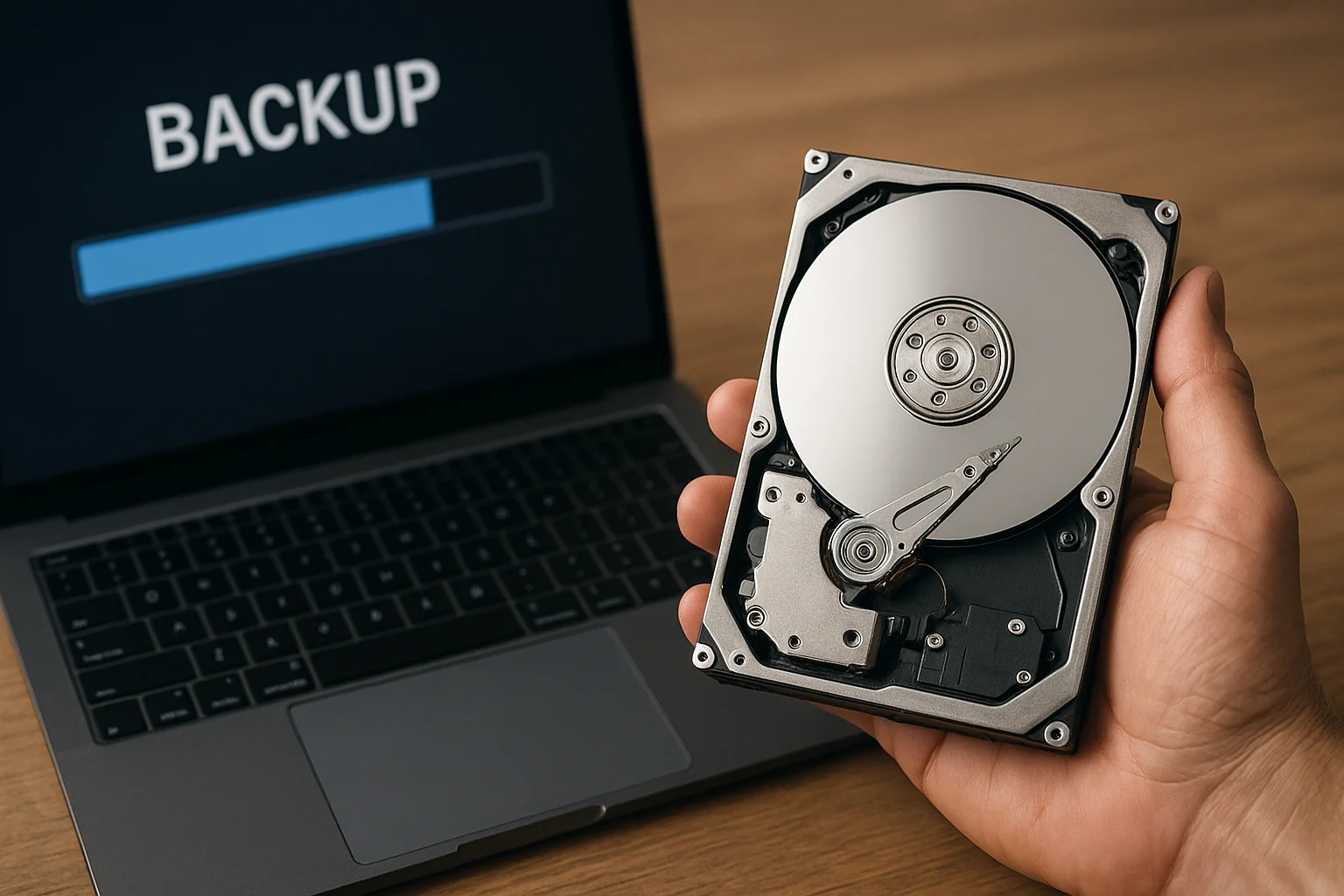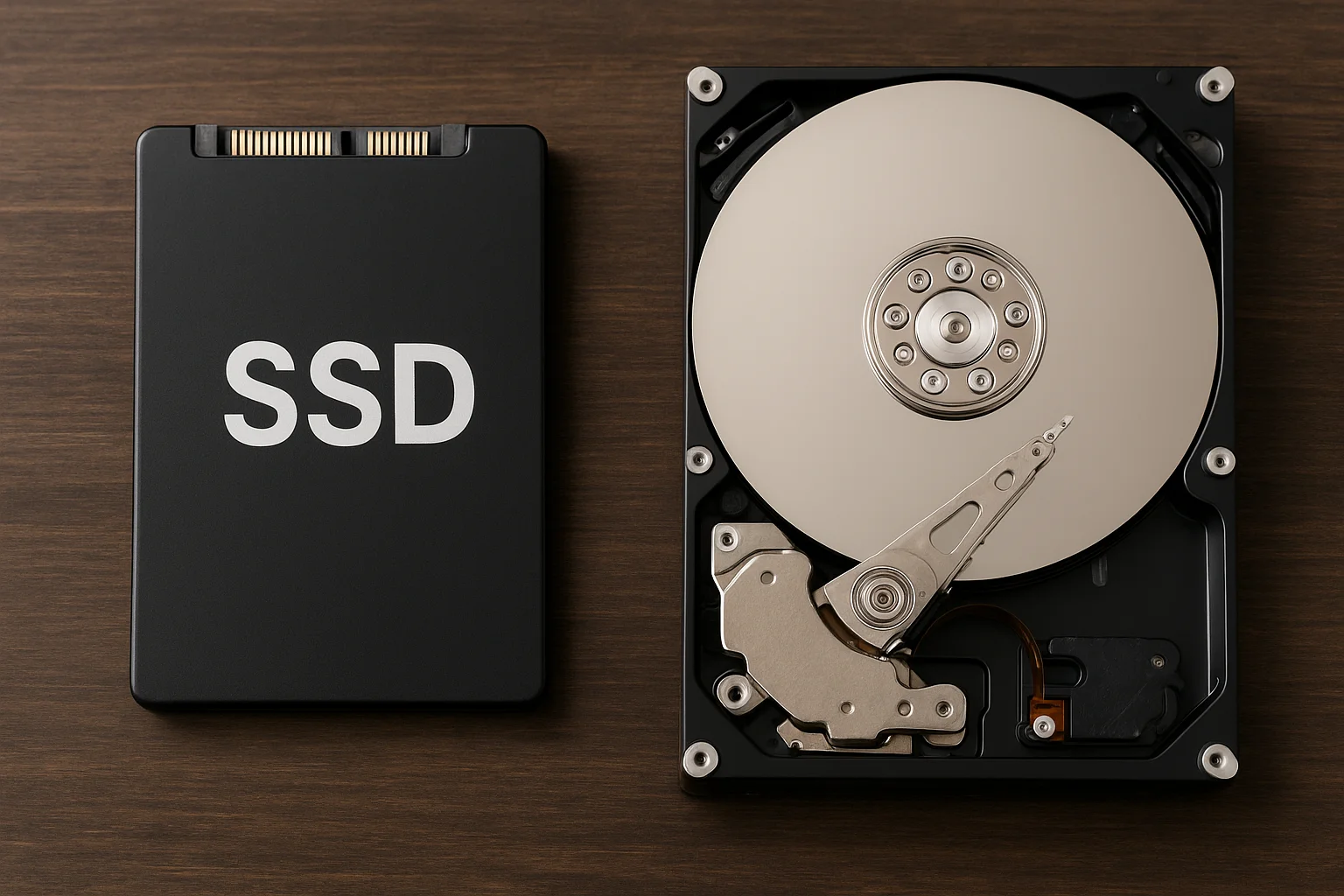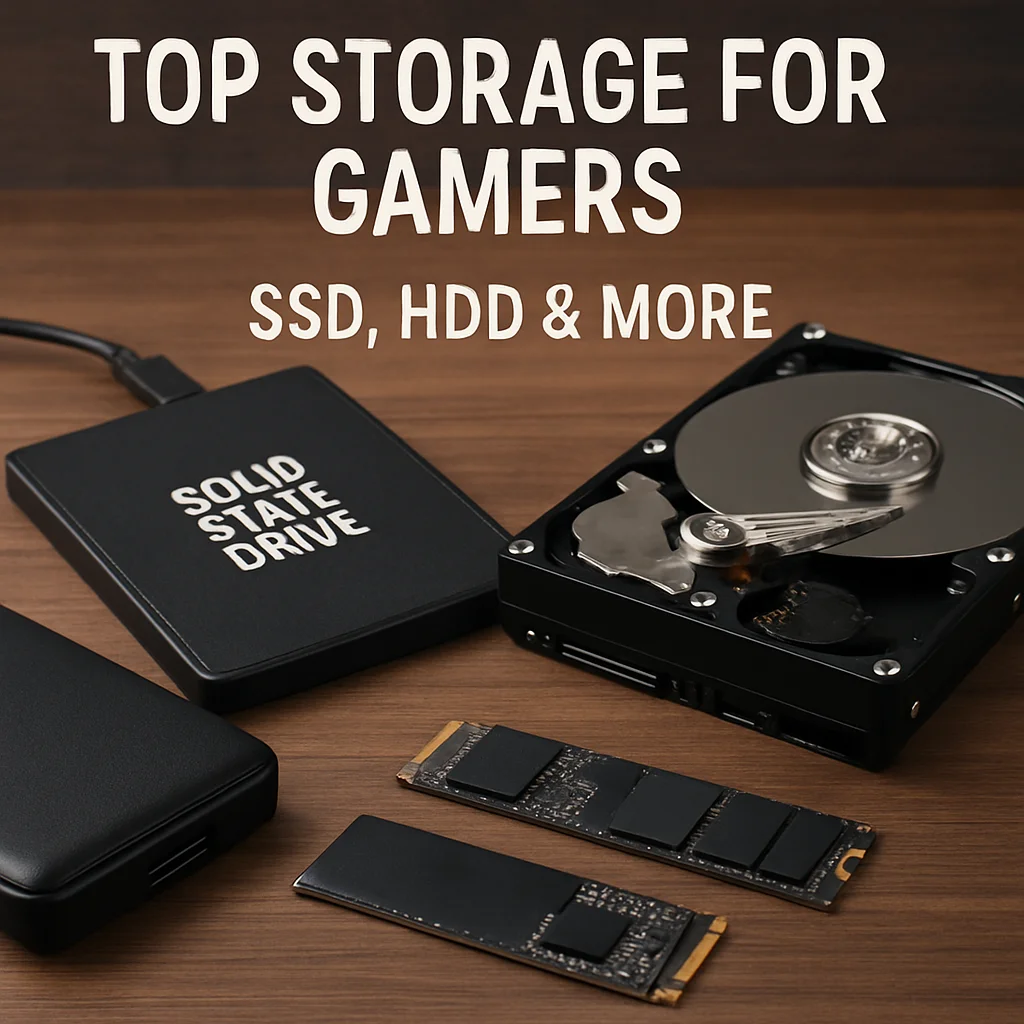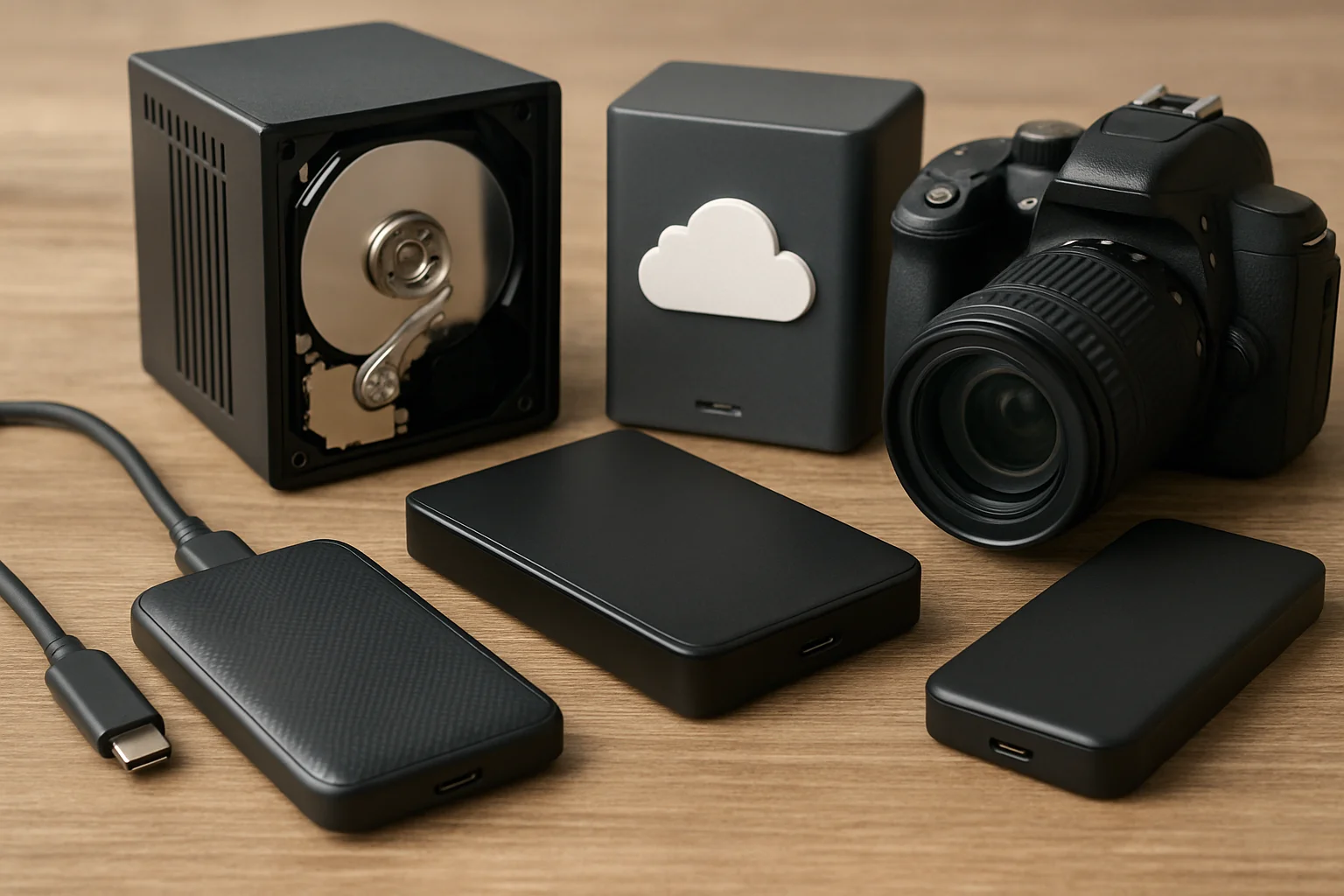Why Storage Matters More Than Ever for Creators
Modern creative work is storage-intensive: higher resolutions, richer formats, multi-camera timelines, and AI-assisted tools all push capacity, speed, and reliability to the limit. The right storage doesn’t just “hold files”—it unlocks smoother edits, faster delivery, and safer assets.
Media Is Bigger, Heavier, and More Complex
Every jump in resolution, frame rate, and bit-depth multiplies storage needs. Even “compressed” codecs add up across takes, proxies, and renders.
| Format (Example) | Approx. Bitrate | ~ Per Hour | What It Means |
|---|---|---|---|
| 4K60 H.264 (100 Mb/s) | ~100 Mb/s | ~45 GB | “Lightweight” capture still grows fast across multi-cam shoots. |
| 4K60 ProRes 422 HQ | ~1.4 Gb/s | ~630 GB | Visually robust editing files demand high throughput. |
| 8K RAW (variable) | ~2–5 Gb/s | ~900 GB–2.2 TB | High-end workflows require SSD/NVMe and fast networks. |
Performance Drives Creative Flow
- Real-time playback: High I/O (sequential MB/s) and low latency (IOPS) prevent stutters when scrubbing timelines, grading, or compositing.
- Scratch & cache disks: NLEs and DAWs write huge temp files; placing caches on fast NVMe dramatically reduces render and conform times.
- Ingest speed: Card offloads and dailies benefit from USB 3.2 Gen 2x2 (20 Gb/s) and Thunderbolt 3/4 (40 Gb/s) to keep crews moving.
- Networked editing: 2.5/10 GbE on NAS lets multiple editors work from the same media pool without constant file copying.
Collaboration, Versioning, and Review
- Shared libraries reduce duplicates and “which-file-is-final” confusion across editors, colorists, motion designers, and clients.
- File locking & versioning protect projects from overwrites and make rollbacks easy after experimental edits.
- Remote workflows depend on smart syncing (selective, on-demand proxies) to align teams across locations and time zones.
Protection Against Loss, Corruption, and Ransomware
- Redundancy (RAID/ZFS/snapshots) guards against disk failure; it is not a backup—creators still need independent copies.
- Offline/immutable backups (air-gapped or object-locked) shield against accidental deletions and ransomware.
- Encryption at rest & in transit protects client assets, NDAs, and unreleased content.
Cost Control and Predictable Delivery
- TCO matters: Balance $/TB, drive endurance, expansion paths, and support/warranty against deadlines and revenue.
- Tiering: Keep hot projects on fast SSD/NVMe, move warm media to HDD/NAS, archive cold assets to cheaper tiers or tape/cloud archive.
- Egress & retrieval: Understand cloud fees and retrieval times so surprise costs don’t hit after client approvals.
AI and Next-Gen Toolchains
- Model and cache sizes (effects, denoisers, voice clones) add tens of GBs that benefit from NVMe speeds.
- Batch exports & upscaling generate heavy intermediates; fast local storage shortens turnaround for deliverables and social cut-downs.
Discoverability and Reuse
- Metadata, previews, and proxies make past shoots searchable, enabling licensing, remixes, and rapid client revisions.
- Consistent folder/naming conventions reduce time lost hunting assets and help assistants onboard quickly.
On-Location Reliability
- Rugged, bus-powered SSDs withstand travel and power constraints while maintaining high ingest speeds.
- Copy verification (checksum) ensures cards are safely offloaded before they’re reformatted for the next setup.
Scalability Without Re-platforming
- Expansion options (empty bays, larger drives, JBODs, or cloud buckets) prevent disruptive migrations mid-season.
- Interoperability with your NLE/DAW, color, and VFX stack avoids bottlenecks and awkward workarounds.
Bottom line: creators need storage that is fast, safe, searchable, and scalable—because every part of the creative pipeline now depends on it.
Key Features to Look for in 2025 Storage Solutions
Performance You Can Measure
- Sequential throughput (read/write in MB/s or GB/s) for smooth playback of high-bitrate media.
- IOPS & latency for snappy timeline scrubbing, previews, and catalog operations; look for low-millisecond or sub-ms latency on NVMe.
- Interfaces: Thunderbolt 4/USB4 (40 Gb/s), USB 3.2 Gen 2x2 (20 Gb/s), 2.5/10/25 GbE on NAS for multi-user editing without copy overhead.
- Thermal stability: sustained speeds without throttling during long writes or batch exports.
Capacity, Endurance, and Media Type
- Right-sized tiers: NVMe for hot caches/projects, SATA SSD for working sets, high-capacity HDD for nearline media, cloud or tape for deep archive.
- Endurance ratings: SSD TBW or DWPD to ensure longevity under heavy scratch/cache workloads.
- Drive technology: prefer CMR HDDs for RAID/NAS; avoid SMR for write-heavy arrays.
- Form factors: M.2/U.2 NVMe for speed; 3.5" bays for economical scaling.
Data Integrity and Reliability
- End-to-end checksums to detect silent corruption (bit rot) on read and write.
- File systems with snapshots and self-healing (e.g., ZFS/Btrfs) to maintain integrity over long projects.
- Power-loss protection on SSDs and robust PSU/UPS options to prevent metadata damage.
- SMART telemetry and early-warning alerts for preemptive drive replacement.
Redundancy and Fast Recovery
- RAID levels matched to workload: RAID 10 for speed+resilience, RAID 6 for capacity+protection, RAID-Z variants for balanced parity.
- Hot spares & rebuild behavior: prioritize systems that rebuild quickly and safely on large disks.
- Snapshots & versioning to revert projects after mistakes or bad renders without a full restore.
Security for Client and Pre-Release Assets
- Encryption at rest (e.g., AES-256) and in transit (TLS) without noticeable performance loss.
- Immutable/WORM options (object lock) to resist ransomware and accidental edits.
- Access controls: granular permissions, SSO/MFA, audit logs for who accessed or changed what.
Collaboration & Workflow Compatibility
- Protocols: SMB/NFS for LAN, S3-compatible object for cloud workflows, and reliable file locking for team edits.
- Proxy-aware sync: on-demand previews/proxies so remote teammates can work without pulling full-resolution media.
- NLE/DAW friendliness: verified performance with your apps (timeline tests, conform/import stability).
Hybrid and Tiered Storage
- Automated tiering between NVMe, HDD, and cloud based on access patterns (hot, warm, cold).
- Local caches for cloud buckets to keep edits responsive while minimizing egress.
- Lifecycle rules to move finished assets to cheaper archive without manual babysitting.
Connectivity and Expandability
- Multiple uplinks: aggregate 10/25 GbE or add NICs as your team grows.
- Empty bays & JBOD options so you can add disks instead of replacing the platform.
- External ports (CFexpress, SD UHS-II, reader docks) to speed up ingest directly into managed volumes.
Manageability and Monitoring
- Clear dashboards for capacity, throughput, latency, and per-user usage.
- Automated alerts via email/webhook when disks degrade, pools fill, or performance dips.
- API/CLI access to script backups, snapshots, and user provisioning.
Backup Readiness
- Native backup targets (S3, cloud archive, LTO) and built-in scheduling with checksum verification.
- Object immutability and cross-region replication to protect against site incidents.
- Fast restore paths for current projects, with granular file/version recovery.
Physical Design for Real-World Use
- Acoustics and vibration tolerances for edit suites and mobile carts.
- Ruggedness on portable drives: shock resistance, IP ratings, and reliable connectors.
- Serviceability: tool-less trays, labeled bays, and accessible filters/fans for quick swaps.
Cost Transparency and Licensing
- Total cost of ownership: hardware, warranties, expansion shelves, cloud egress/retrieval, and optional software licenses.
- Predictable scaling without per-user or per-feature surprises that penalize growth.
Sustainability and Power
- Energy-efficient CPUs/drives and spin-down policies for idle tiers.
- Thermal headroom to keep components within spec under heavy renders or multiple concurrent edits.
Metadata and Discoverability
- Automatic previews/proxies for quick skimming of footage and graphics.
- Tagging and searchable metadata to locate takes, versions, and deliverables rapidly.
Cloud Storage Options Tailored for Creators
Cloud platforms can function as primary workspaces, review hubs, or archives. Choosing the right option depends on team size, locations, codecs, and delivery timelines. Focus on sync behavior, proxy support, egress costs, and security controls that match real creative workflows.
Core Capabilities That Matter in the Cloud
- Desktop sync & on-demand files: pull proxies/thumbnails locally while leaving originals in the cloud; ideal for remote edits and quick reviews.
- Proxy-first workflows: auto-generate edit-friendly proxies and audio previews so collaborators don’t download full-resolution media unnecessarily.
- Smart versioning: keep history on project files (timelines, graphics, audio stems) with conflict resolution and visual diffs where possible.
- Accelerated transfer: multi-part uploads, UDP acceleration, or edge ingest to reduce time for dailies and returns.
- Media-aware previews: in-browser playback for common codecs, frame-accurate scrubbing, timecode display, and comment markers.
- Automations: triggers for transcode, QC checks, metadata extraction, and movement between tiers (hot → archive) without manual steps.
Security & Compliance Essentials
- Encryption at rest and in transit; prefer BYOK/KMS options if you manage your keys.
- Role-based access, SSO/MFA, granular share links with expiry, passwords, and watermarking for pre-release cuts.
- Immutability / Object Lock for deliverables and finals to protect against ransomware or accidental edits.
- Audit logs and legal holds for client reviews and regulated shoots.
- Regional choice: select data regions close to editors to reduce latency and meet residency requirements.
Comparing Cloud Approaches by Use Case
| Use Case | Priorities | Useful Features | Watch-Outs |
|---|---|---|---|
| Remote team editing | Low-latency proxies, fast sync, file locking | On-demand files, partial sync, NLE-friendly paths | Egress fees for originals; ensure predictable caching |
| Client review & approval | Secure sharing, comments, timecode notes | Watermarked previews, expiring links, annotations | Permission sprawl; standardize share policies |
| Team media library (MAM/DAM) | Searchability, metadata, taxonomy | AI tagging, custom fields, collection sets | Indexing costs, need clear naming conventions |
| Archive & long-term retention | Low $/TB, durability, immutability | Lifecycle rules, cold tiers, checksums | Retrieval delays and restore fees on deep archive |
| Global delivery | High availability, edge distribution | CDN, signed URLs, regional replicas | Cross-region replication costs |
Object Storage vs. Sync Drives
- S3-compatible object storage: excellent for scalability, automation, and cost control; pair with desktop gateways or cache appliances for editor-friendly mounts.
- Cloud sync drives: simpler UX for creatives; ensure robust selective sync, file locking, and reliable handling of large project folders.
Performance Considerations
- Where proxies live: store proxies at the edge or locally for instant playback; originals can remain in object storage until conform/delivery.
- Throughput: use multi-connection uploaders and resume support for big renders; verify your provider’s per-file and per-request limits.
- Latency: choose a region near your editors and enable local caching on workstations or NAS gateways.
Cost Controls
- Egress awareness: downloads, cross-region traffic, and inter-service moves can add up; prefer workflows that edit from proxies and conform selectively.
- Lifecycle policies: automatically move inactive assets to colder tiers; set retention on finals and clear temp renders weekly.
- Compression & dedupe: archive mezzanines instead of intermediates when acceptable; avoid storing duplicate camera cards and proxies indefinitely.
Metadata & Discoverability in the Cloud
- Automatic previews and thumbnails for quick skimming by producers and clients without downloads.
- Rich metadata: tags, shot lists, rights windows, release forms, and usage notes stored with the asset.
- Search across filenames, tags, captions, and timecoded comments to find b-roll and alt takes quickly.
Hybrid Cloud Patterns That Work
- Cloud + NAS gateway: mount buckets as network shares; hot files cached on-prem for speed while the cloud stays authoritative.
- Local NVMe for scratch plus cloud sync for project files; publish only finals/originals to cloud to cut bandwidth usage.
- Tiered archives: keep current season in “warm” object storage; migrate previous seasons to deep archive with object lock.
Collaboration & Review
- Timecode comments and range-based notes to communicate precise edit requests.
- Share presets: enforce watermarks, expiries, and download permissions per-folder or per-project.
- Notifications via email/webhooks when reviewers comment, approve, or when automations finish transcodes.
Data Integrity in the Cloud
- Checksums on upload and periodic fixity verification to detect silent corruption.
- Versioned buckets with lifecycle rules to retain only necessary generations and prevent accidental overwrites.
- Cross-account backups or second-region replicas with restricted credentials for disaster scenarios.
Practical Setup Checklist
- Choose a primary region near editors and enable a read-only replica for clients if needed.
- Define folder structure, naming, and metadata fields before ingesting your back catalog.
- Enable SSO/MFA, create least-privilege roles, and audit share links monthly.
- Turn on automatic proxy generation and set expiry for temporary renders and cache folders.
- Document restore paths: how to rehydrate proxies/originals for conform and how to handle cold-tier retrieval delays.
External Hard Drives & SSDs: Fast and Reliable On-the-Go
Portable drives underpin fieldwork: they handle ingest, backup, and edit-anywhere tasks. Choosing the right model and setup impacts transfer times, data safety, and how quickly you ship cuts from the road.
HDD vs. SSD in the Field
- Portable HDD (2.5"/3.5"): high $ / TB value, adequate for backups and nearline storage. Slower (typically 120–170 MB/s per drive), sensitive to drops/vibration, and may need external power for 3.5" units.
- Portable SATA SSD (2.5" or USB enclosure): faster than HDDs (400–560 MB/s), shock-resistant, silent. Good for working sets and quick offloads.
- Portable NVMe SSD: top-tier performance; burst speeds can exceed 1,000–3,000 MB/s depending on interface. Ideal for camera card offloads, on-location editing, caches, and renders.
Interfaces That Dictate Real Speed
- USB 3.2 Gen 2 (10 Gb/s): real-world up to ~1,000 MB/s with NVMe. Most common and broadly compatible.
- USB 3.2 Gen 2x2 (20 Gb/s): up to ~2,000 MB/s when both host and drive support it. Not all laptops support 2x2.
- Thunderbolt 3/4 / USB4 (40 Gb/s): can sustain 2,500–3,000+ MB/s on fast NVMe. Daisy-chaining and power delivery benefits in pro setups.
- Cables matter: use short, certified cables; mismatched or charge-only cables can cap speeds or cause disconnects.
Real-World Performance Factors
- Sustained vs. burst: many portable NVMe SSDs use SLC cache; after large writes, speed may drop substantially. Check sustained write behavior for long offloads.
- DRAMless controllers rely on HMB; fine for light work, but DRAM-equipped models maintain speed during heavy, fragmented writes.
- Thermal throttling: aluminum shells help, but long transfers can still heat-soak. If you see dips, allow cooldown or use drives with better heat dissipation.
- ExFAT vs. NTFS/APFS: exFAT eases cross-platform use but lacks journaling; APFS/NTFS are more resilient. Consider a dual-drive strategy for cross-OS teams.
Ruggedness & Reliability On-the-Go
- Shock ratings and IP (ingress protection) markings indicate drop and dust/water resistance. SSDs generally handle impacts far better than HDDs.
- Mounting & strain relief: cable strain can cause intermittent disconnects; route cables away from traffic and secure them with velcro ties.
- Power stability: bus-powered drives are convenient; for multi-drive enclosures or high draw, prefer externally powered hubs to avoid brownouts.
Capacity Planning for Mobile Work
| Scenario | Suggested Capacity | Why |
|---|---|---|
| Day shoots (single cam 4K60) | 1–2 TB NVMe SSD | Fast offloads and space for dailies, proxies, and a render pass. |
| Multi-cam events / week on tour | 4 TB NVMe + 8–12 TB HDD | SSD for ingest/edit, HDD for nightly backups and retention. |
| Photo-heavy travel | 2 TB SATA/NVMe SSD | Room for RAW bursts, previews, and catalogs. |
Data Integrity & Security Basics
- Checksum verification (e.g., MD5/SHA-256) after copy ensures camera cards are safely duplicated before format.
- Hardware encryption (AES-256) with password/PIN can protect pre-release assets if the drive is lost.
- Write-protect strategy: keep a read-only copy of critical media on a separate drive until verified backups exist.
On-Set / On-the-Road Workflow Tips
- Dual-copy habit: create two independent copies (ideally SSD + HDD) before clearing cards.
- Labeling: unique drive names and folder templates reduce confusion under time pressure.
- Safely eject to flush caches; sudden unplugging risks corruption, especially on exFAT.
- Cable kit: carry spare USB-C to USB-C, USB-C to A, and a short Thunderbolt cable; include a compact powered hub.
Enclosures & Docks
- NVMe enclosures: choose ones that disclose controller, thermal pad/heatsink design, and support for your host interface.
- Tool-less access simplifies swapping SSDs between projects; keep anti-static pouches for spare blades.
- Reader integration: card readers (CFexpress/SD UHS-II) connected via 10–40 Gb/s links prevent ingest bottlenecks.
File Systems & Catalogs
- Per-project drives: reduce cross-project contamination and make handoffs simpler to clients or collaborators.
- Catalog location: store NLE/DAW catalogs and caches on the same fast SSD to avoid path issues and keep previews responsive.
- Health checks: periodically run file system checks; monitor SMART/NVMe health stats for early failure signs.
Endurance & Lifespan
- TBW/DWPD ratings: heavy scratch/render workloads favor higher-endurance SSDs; log writes during large projects.
- Spare area: leaving 10–20% free helps maintain write speed and wear leveling.
- Firmware updates: keep drives current to resolve stability and performance issues.
Troubleshooting Common Bottlenecks
- Underperforming speeds: check port capability (some USB-C ports are USB 2.0), cable rating, and that the drive is not thermal throttling.
- Random disconnects: avoid bus-powered hubs for multiple high-draw devices; test with direct ports or powered hubs.
- File copy stalls: disable aggressive sleep settings, ensure enough free space for SLC cache, and try verified copy tools.
Practical Packing List
- 1–2 fast NVMe portable SSDs for ingest/edit.
- 1 large-capacity portable HDD (or two) for rolling backups.
- Short certified cables, USB-A adapter, and a small powered hub.
- Shockproof case with labeled pouches and silica gel packs.
